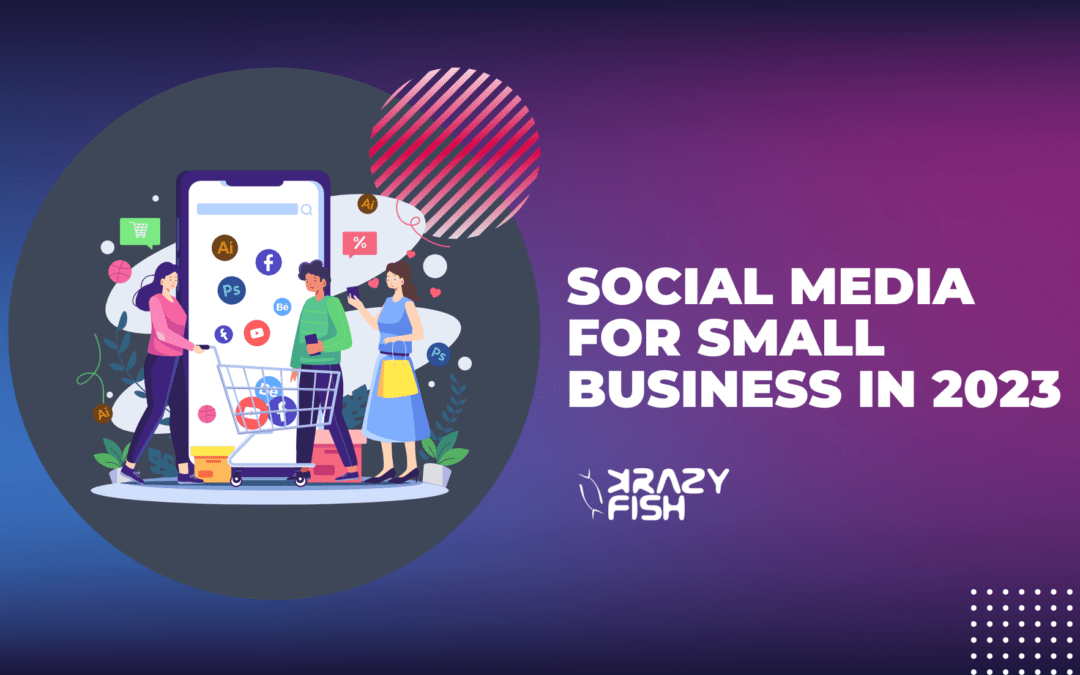Most people who have sunk any amount of time and money into social media marketing for their small business will tell you that’s a load of hoo-ha. And we agree. Sort of.
Social media marketing is supposed to do wonders for businesses everywhere. From attracting new customers to getting viral, nationwide attention for your brand – it’s supposed to be the one-size-fits-all magic wand that will make your business a success. But a lot has changed since the early adopter days of social media and it’s gotten a little more complicated than just being present on various networks.
Get to the Point
Like with most other things, the short answer to this question is – follow the money.
And that’s exactly what big social has done. In its inception, social media may have been just a set of great tools for people to communicate quickly and with more people than ever before. In the meantime, social networking companies with a viable audience have grown into media and advertising companies that make money from big, consumer-facing businesses that spend perverse amounts of money on pushing their products and services on users.
And, as usual, small businesses got left behind. Or, rather, small businesses mostly failed to adapt to these new tools and channels that weren’t built with them in mind. Despite the fact that big social is now built for big business, small businesses can and should benefit from these tools. And here’s how.
Forget one-size-fits-all. It doesn’t. There is no right answer to the question “Which social network is best for small businesses?” All businesses are different. All business owners are different. If they weren’t, every Italian restaurant in every major city in the world would be the same and you wouldn’t have a favorite coffee spot ever.
Do what’s right for you. Finding the right social media channel for your business is as easy as answering these three questions:
Which social media network do your ideal customers already spend a lot of time on?
Are you any good or can you become really good at creating the ideal content for that social network?
Is that social network a good fit for your industry overall?
Find the ONE channel that is the intersection of those three factors and you’re in for a helluva ride. If you’re interested in hearing a little more about that whole concept, take a look at the video below.
The ONE channel theory
With so many to choose from and things changing so frequently, picking the one right channel still seems too complicated, right? Why would you risk picking the wrong one? Why not try a few and see what works? Whatever happened to not putting all of your eggs in one basket?
Think of it as a process of elimination or a good start. We’re not saying you should stick to one channel forever or no matter what.
The plain facts of it are that small business owners, even if they have staff, have neither the time, the skills, nor the resources to manage and create content for several different social media channels. You are not marketers.
So the only way social media marketing is ever going to bring you a significant return on investment is if you a) don’t overinvest in it and b) do one channel right.
To make it a little easier on you, we’ve compiled a list of major social media networks you can consider selecting that channel from and we’ll be covering each of these networks in a series of videos on our brand new YouTube channel, with examples of successful small business social media accounts on each network.
YouTube
Truth be told, everything is all about video from here on in. A major U.S. cell phone service provider reported that over 80% of all data traffic on their network was spent on mobile video viewing.
How it works: YouTube is much more than a video app. It’s a social network in and of itself and the world’s second biggest search engine. Really it’s just a part of THE biggest search engine, Google. Search is a huge feature on YouTube. Focus on keywords related to your business and keep in mind that users frequently search for how-tos on YouTube.
Explore YouTube for Small Business.
Pros:
- High chance of visibility if you create solid and consistent video content.
- Video content allows you to literally SHOW potential and existing customers your business, your product, how you do things, and a little backstage action they would otherwise never see.
- Shareable to other networks.
- Link placement (backlinks) in video descriptions are a great way to distribute other content and get more traffic.
- Low advertising costs.
Cons:
- No narrow geotargeting. I.e. local brick-and-mortar businesses can’t target and attract customers from just their neighborhood.
- Requires effort for growth and maintenance.
- Requires video creation and editing skills or a significant budget and time.
What kind of content works:
- YouTube Shorts will get you fast and easy attention, but that attention is going to be brief. Consider whether that really does anything for your business. Great for introducing new dishes a restaurant may have added to their menu, but probably won’t mean a thing if you’re selling software.
- Standard YouTube videos of 3 to 5 minutes or over 20 minutes, where you either explain the inner workings of your business or create entertaining content while showcasing your products and services will get fewer views than Shorts but represent your business and brand for years to come.
Despite possibly being the leader in big business social media advertising, Facebook has a bunch of underused tools for SMBs available. In fact, Facebook’s parent company Meta has a whole social media for small business tool set.
Discover Facebook tools for small business.
Pros:
- Great for driving traffic to your websites or products.
- Very low cost and versatile digital advertising products.
- Community building and lead nurturing features.
- Multiple types of content work on this platform.
- Hyperlocal and / or very specific advertising targeting.
Cons:
- Complexity. Facebook has built a monster Business Suite with layers upon layers of features, which means there’s a learning curve. Start with the basic features and then learn how to use the other features, one by one.
- Low engagement. Again, unless you’re a standup comedian in your spare time or can create highly entertaining content, Facebook users are growing more difficult to engage by the day.
- Time. Facebook needs daily content and management.
What kind of content works:
- Live video. Whether it’s an Ask Me Anything session, a webinar or just live streaming from your restaurant kitchen, the only thing more popular than on-demand video on social networks is live streamed video.
- Native video. While video is probably not a viable direction for Facebook to be moving in, it’s what Meta’s doing anyway, so native video is going to be the preferred content until further notice. In other words, videos that you upload to the platform will be pushed by Facebook and be seen by more people.
Oof. How do we put this politely? We can’t. Twitter is pretty much useless to small businesses, with the exception of two use cases.
How it works: Twitter is all about hot topics and conversations. This means that, if your brand is present on this channel at all, you must engage in conversation with other users and brands there daily and pushing your own topics will be difficult, at best.
Explore Twitter’s small business resources.
Pros:
- Umm… it’s mostly free to use?
Cons:
- Too much noise.
- Unless you’re very entertaining or controversial, users there will seldom engage with your content and even then, favoriting or retweeting don’t bring many real world results.
What kind of content works:
- Conversations. If you are a consumer brand and need a channel for larger volume customer service type stuff, Twitter is a great tool for that. Although that’s not really a marketing channel then.
- Content distribution using links and images in tweets. You will probably need to boost content with paid ads on Twitter, but it’s a fairly effective way of getting more traffic to your content, if you are a media company or “selling” any type of digital content.
Another great set of tools for small business, depending on your niche, by none other than Meta. For most small businesses and solo content creators, Instagram beats TikTok with just the fact that the platform makes room for more than one type of content.
Getting started with Instagram for Business.
Pros:
- Great for driving traffic to your websites or products.
- Very low cost and versatile digital advertising products.
- Multiple types of content work on this platform.
Cons:
- Focused more on visibility than selling. Not necessarily a bad thing if you’re looking for website traffic but don’t count on getting a lot of great leads or sales here.
- Low engagement rates.
- Effort. Photo and video skills are a must and to get the most out of Instagram, you should be posting Reels a couple of times a day, every day.
What kind of content works:
- Reels. Short videos by the name of Reels are the name of the game on Instagram these days, though they will get you attention only briefly and require a lot of effort.
- Stories. We know Stories don’t make sense to a lot of folks, but there is method to the madness. Unlike Reels, Stories are a great way to organize and showcase your products and services into Highlights on your Instagram profile. If you’re looking to sell anything on social media, think of your Instagram profile as a web shop hosted on a social media platform.
- Image carousels with long-form text. Hear us out on this. A collection of images set up in a carousel format with an almost blog post like text to go with it can really tell a story. And is possibly the best way to induce engagement on Instagram. Think story book and run with it.
In terms of marketing on social media for small business, LinkedIn may be the single most underrated channel, especially for consultants, solopreneurs, and B2B brands. This is the home of all things business, so if your ideal customers are other businesses or decision-makers, LinkedIn is your new hangout.
How it works: LinkedIn is a combination of conversations and informative content, whether in long-form text or video format.
See what LinkedIn Pages can do for small business.
Pros:
- Specific niche of users – it’s all about business.
- Easy to find and connect with people and groups in your industry.
- Several types of content work on LinkedIn, so more likely you’ll find a good fit.
Cons:
- Fast moving feed. LinkedIn’s feed looks and moves more like Facebook’s feed these days.
- LinkedIn Ads are costly and inefficient for most businesses, unless you’re recruiting or selling enterprise software.
- Time. It takes time to build a network and establish a presence on LinkedIn.
What kind of content works:
- Long-form text updates and articles. Especially with the new algorithm updates, LinkedIn LOVES long-form content that displays your professional expertise and attracts conversation and comments.
- Video. Have we mentioned that video is king?
- Comments and conversations. Engaging in conversations on other users’ posts and in groups can get you fantastic results.
TikTok
Until recently, TikTok was the most popular social network in the world and still remains the leader among younger generations.
How it works: TikTok refuses to be called a social networking platform and much prefers the term “video sharing platform.” That about covers it.
Take a look at TikTok for Business.
Pros:
- Very welcoming to beginners and all levels of video quality.
- Great for targeting Gen Z consumers.
Cons:
- Video content only.
- Your audience may know TikTok as “that app the kids are on these days.”
- High cost of content production for this platform.
- Fast-moving timeline with low viewing retention rates for the average account.
What kind of content works:
- Short videos. Because video. Also, video.
Pinterest is extremely good at driving traffic to websites and increasing leads for product sales, especially in certain industries. Would you believe financial services is one of those industries? Yeah, it’s not just interiors and crafts on there.
How it works: Pinterest is all about visuals and links. Aside from standard posts, Pinterest has recently turned its social networking attention to product (sales) posts and, you guessed it, video.
Explore Pinterest small business resources.
Pros:
- Very welcoming to beginners.
- The one viable platform for small businesses that doesn’t REQUIRE video content.
- Built-in search engine optimization
- High referral rates
Cons:
- A lot of noise.
- Industry / niche focused. There are a lot of niches and target groups that Pinterest is geared toward, but if your industry is not among them, you won’t get any results.
- Copyright infringement issues. Make sure you are creating content which you own or have permission to the rights for.
What kind of content works:
- Images. There might be a little bit of a learning curve for some folks here because Pinterest really has a preference for high quality, eye-catching image content.
- Video. Have we mentioned video. Video, video, video.
- Requires constant attention and activity.
Bonus tip: If you’re just getting started with your small business, don’t forget the first mandatory step in establishing a digital presence for your new venture – a website. Here’s how to get started with local SEO for your small business website.




